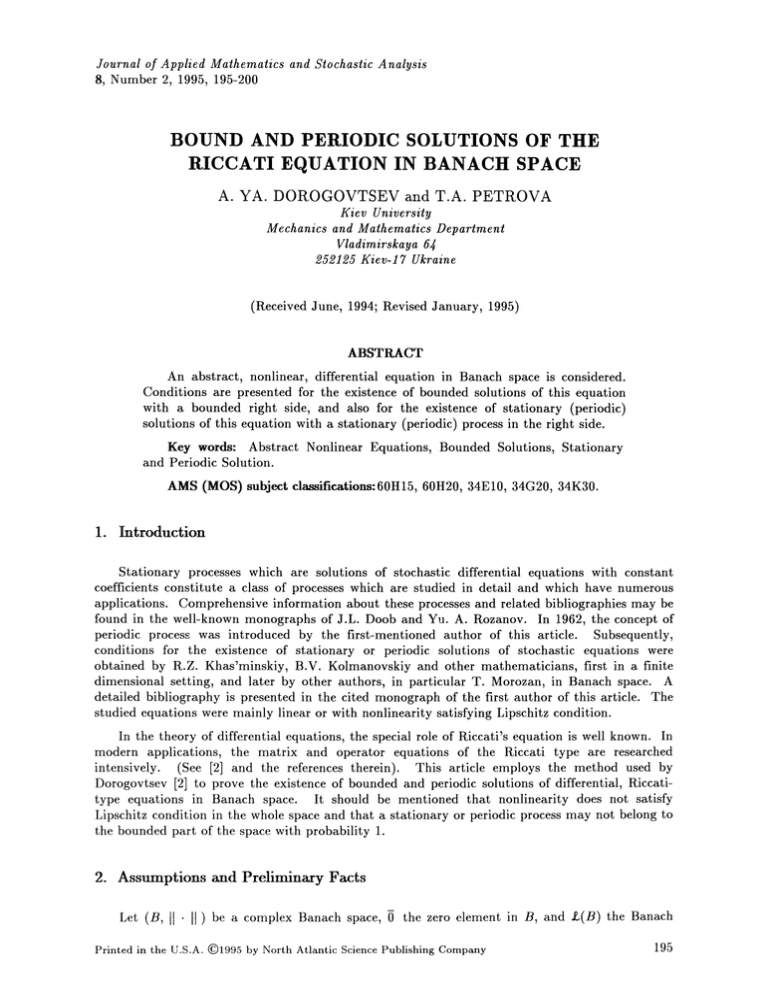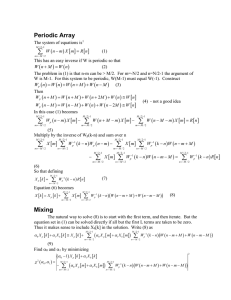EQUATION AND THE IN
advertisement

Journal of Applied Mathematics and Stochastic Analysis
8, Number 2, 1995, 195-200
BOUND AND PERIODIC SOLUTIONS OF THE
RICCATI EQUATION IN BANACH SPACE
A. YA. DOROGOVTSEV and T.A. PETROVA
Kiev University
Mechanics and Mathematics Department
Vladimirskaya 6
252125 Kiev-17 Ukraine
(Received June, 1994; Revised January, 1995)
ABSTRACT
An abstract, nonlinear, differential equation in Banach space is considered.
Conditions are presented for the existence of bounded solutions of this equation
with a bounded right side, and also for the existence of stationary (periodic)
solutions of this equation with a stationary (periodic) process in the right side.
Key words: Abstract Nonlinear Equations, Bounded Solutions, Stationary
and Periodic Solution.
AMS (MOS)subject classifications:60H15, 60H20, 34E10, 34G20, 34K30.
1. Introduction
Stationary processes which are solutions of stochastic differential equations with constant
coefficients constitute a class of processes which are studied in detail and which have numerous
applications. Comprehensive information about these processes and related bibliographies may be
found in the well-known monographs of J.L. Doob and Yu. A. Rozanov. In 1962, the concept of
periodic process was introduced by the first-mentioned author of this article. Subsequently,
conditions for the existence of stationary or periodic solutions of stochastic equations were
obtained by R.Z. Khas’minskiy, B.V. Kolmanovskiy and other mathematicians, first in a finite
dimensional setting, and later by other authors, in particular T. Morozan, in Banach space. A
detailed bibliography is presented in the cited monograph of the first author of this article. The
studied equations were mainly linear or with nonlinearity satisfying Lipschitz condition.
In the theory of differential equations, the special role of Riccati’s equation is well known. In
modern applications, the matrix and operator equations of the Riccati type are researched
intensively. (See [2] and the references therein). This article employs the method used by
Dorogovtsev [2] to prove the existence of bounded and periodic solutions of differential, Riccatitype equations in Banach space. It should be mentioned that nonlinearity does not satisfy
Lipschitz condition in the whole space and that a stationary or periodic process may not belong to
the bounded part of the space with probability 1.
2. Assumptions and Prehminary Facts
Let (B,
I1" lid
Printed in the U.S.A.
be
complex Banach space,
(C)1995 by North
the zero element in
Atlantic Science Publishing Company
B, and (B) the Banach
195
A. YA. DOROGOVTSEV and T.A. PETROVA
196
space of bounded linear operators on B with the operator norm, denoted also by the symbol
I1" I1" For the function y:N-*B we define
Function x: N-*B is differentiable in the point t o E
if an element, y E
I- 0,
y
t- t o
,
exists such that
t-,t o.
The element y is called the derivative of function x at the point t o and is denoted by the symbol
x’(to). With the help of this definition, the class CI(,B) is defined by the usual manner. In
addition, the continuity of function x at the point t o means that
I x(t)- x(to) I -*0, t-*to.
For the operator A
(B) and function y C(,B) we consider the equation
dx(t) Ax(t) y(t)’ t ff
(1)
+
dt
with respect to function x cl(,B). Equation (1) is investigated in detail. We shall formulate
the necessary facts about properties of the solutions of equation (1) without proof. Details are
presented in [2, 3].
We consider operator A whose spectrum r(A) does note intersect with imaginary axis and
which consists of two sets, r (A) and r + (A), where
r_ (A) a(A)R {z Rez < 0},
r + (A) r(A)R {z Rez > 0}.
In addition, (r(A)--r_ (A) Ur+ (A). According to the well-known theorem of M.G. Krein [4],
the structure of the spectrum which we have considered is equivalent to a unique solution of
equation (1) x CI(N,B) with
existing for any function y e C(,B) with
< +
Let P + and P_ be spectral projectors [2, 3], and P_ and
y
operators in
< +
(B) such that
P +P_ -P_P+ -0 (0 is zero operator)
I I
.
I I
P
P+
P,
P_A-AP,
for which B_
P_ B, B +" P + B are invariant subspaces for operator A. The spectrum of
operator A in these subspaces coincides with r_ (A) and r + (A), respectively. Also, we consider
operators
A+"
and, in addition, A_ +A
P +A, A_"
P_A,
-A. With the help of spectral projectors
we define the
operator
valued function
G(t):
etA-p_,
tA
-e
t>O
+ P +,
t
> O.
It is known [2, 3] that
I c(t)Ii <
where c_,
c+to are
corresponding
C_e
c+e
tc
-,
t<O
+
t>0
non-negative numbers and a_, a+ are positive numbers.
operator A are fixed below. We denote
The numbers
Bound and Periodic Solutions
of the
-
Riccati Equation in Banach Space
c
-a--_ ac++.
"
With the help of function G we can write the unique solution x E
equation (1) for the function y e C(N,B),
< + o in the form
I I
f
] a(t- )()d,
(t)
We understand the integral in (3)
as the limit
t
197
CI(N,B),
e
(3)
integral sums in B.
(For details,
see
[4].)
3. Existence of Bounded Solutions
Let b: B B-B be
a function that is linear in each
::1
C > 0 V{u, v} C B:
variable, such that
_< C I
I b(, v)II
I I v II-
(4)
Theorem l" Let operator A satisfy the conditions of p.1; B is a bilinear function such that
inequality (4) is true with a number C, and a function y C(,B), Y
< + oc. Assume that
the inequality
4c y < 1
is true.
Then equation
dx(t) Ax(t)
()
+ b(x(t), x(t)) + y(t), t
dt
I I
I I
has a solution x with
I I
<
CI(N,B).
/ o i th class
4. Subsidiary Statements
,
I1Y I < + equation
dxo(t)
Ax(t) + y(t)’ t e
dt
has a unique solution x 0 e cl(, B) with I 0 I < +
moreover,
For the function y e C(N, B) with
,
o(t)
f
/ G(t
)()d, t e
(6)
(7)
It is easy to verify that
and it follows from
(4)
I b(0,0)II o < +
dXl(t)
dt
has a unique solution x
.
-
Therefore, equation
AXl(t) + b(x(t)’x(t))’
cl(,B) with I Xl I c
/ a(tand
(8)
t
eg
(9)
oo, moreover,
x0(@,
I I cx --< C3 I y I 2,
(10)
(11)
n >_ 2
Now, we construct the sequence of functions {Xn’n >_ 1} as follows: Assume that for
functions Xo, Xl,...,Xn_ have been already defined as unique solutions of equations in a class
CI(,B) NCo(,B)
__
A. YA. DOROGOVTSEV and T.A. PETROVA
198
Axk(t + yk(t),
df
where
E R; l
k
(12)
n-1.
k-1
In addition,
o
j
k
k+1
< C2k1--cF2k + lCk [[Yl]o
I Xk I o-k+
We also define Y0: Y, Yl: b(Xo, Xo) and note that estimate
and x 1 defined above, for k 0 and k 1, respectively.
Function
estimate
n- 1
is true for the solutions x 0
(13)
allows the
n- 1
--
=o
n-1
Cj,2j T1cJ I Y I +1
C
j+l
=0
C2( n
=o
j
j
j-
n-j
-c 2llyll
1). 2n- 2j 1cn- j
-1
j=0
Cj
c(x__)
j+l
n-j
cmc
I
+1
n
The last step of the derivation uses identity
Now,
(13)
with the help of inequalities
Yn constructed by Xo, Xl,...,xn_ 1
j
(13)
l<_k<_n-1.
y
1
y
[ n- j
1
(14)
-1
II"
ll(a) from
[6, p. 123].
C(a,B)a C(a,B) of equation
Riordan
we define function x n as a unique solution in the class
x.(t)+ .(), e
,
()
moreover,
and it follows from estimates
(8)
and
(14)
I1.11 <
that
CiE2n+lcn
n+l
Therefore, estimate (17) is true for x,, i.e., estimate (13) is true for k
n.
5. Proof of Theorem 1
We consider the function
x(t)"
E Xn(t)’
e R,
(18)
n--O
which has been constructed using the sequence of functions in section 2. It follows from
the series in (18) converges uniformly on N in the norm, since
O0
I
I o<
Crn
n
C2nc2n+Icrt II
n+1
n-l-l (2C I
II n-t-1
I )’ I , I
.
(17)
that
Bound and Periodic Solutions
Since
n
C2n
the last series converges, if
Riccati Equation in Banach Space
of the
,
22n
n--
199
+
Therefore, x E C(N,B). The series of derivatives corresponding to series (18) also converges
uniformly on N in the norm, since
E x(t) Axo(t + y(t)
+ E (Axn(t) + Yn( t))’ t
n’-0
n=l
according to the definition of functions
that
xn,
n
>_ O,
n+lC2nn(2CllYll oo)" I
+ IIAII
y
and it follows from estimates
I
oo
C 1(, B) and
Therefore, x
E x(t)
x’(t)
Axo(t + y(t) +
We note that according to the definition of {Yn}
N
N
n-1
n=l
n=l
j=0
E Yn(t) E E b(xj(t),
Since for each t
R
_
x n -1
j(t)),
rt
1, t e
.
.
oo
3=0 k=0
it follows from condition
(4)
and estimates
(17) that for each E N in the B-norm
N
N
E Yn(t)
lim
N-- + cx: n--1
lim
N+oo
N
lim
N--*
+
E
b(xj(t)’xk(t))
j,k=O
N
xj(t), E xk(t))- b(x(t),x(t)).
b(E
k=0
j=0
Therefore, from equality (19) it follows that
x’(t)
Ax(t) + y(t) + b(x(t),x(t)),
Theorem 1 is proved.
6. Periodic Solutions
Let
-
> 0 be fixed and function A C(N,L(B))
Let U:N(B) be
is such that
VteN:A(t+r)-A(r).
a solution
of the following problem
e
and
(14)
Ilyll oo
E (Axn(t) + Yn (t))’ t e
n=l
n=0
(8), (17)
.
(19)
A. YA. DOROGOVTSEV and T.A. PETROVA
200
U’(t)- A(t)U(t),
u(0)- E
tE
where E is the identity operator. The properties of the function U below are well-known [5]. The
following statement is proved in a similar way for Theorem 1 by results of [1].
7,
Theorem 2:
the equation
If 1 a(U(r)),
d(t)
dt
ha a
-odc otuto
th
then
for
every
function y G C(,B)
A(t)x(t) + b(x(t),x(t)) + y(t),
ca C(,B) o
th
t
which is periodic with period
e
a ouh
I.
References
[1]
[2]
[3]
[4]
[5]
[6]
Dorogovtsev, A. Ya., Periodic and Stationary Regimes of Infinitely Dimensional Deterministic and Stochastic Dynamic Systems, Vischha Shkola, Kiev 1992 (in Russian).
Dorogovtsev, A. Ya., On periodic and bound solutions of the operator Riccati equation,
Ukrainian Math. J. 45:2 (1993), 239-242.
Hille, E. and Phillips, R., Functional Analysis and Semi-Groups, AMS Colloquium
Publications, Providence, RI 1957.
Krein, M.G., Lectures of the Stability Theory of Solutions of Differential Equations in
Banach Space, Inst. Techn. Inf. Academy Sci. Ukraine, Kiev 1964.
Massera, L.J. and Schaffer, J.J., Linear Differential Equations and Functional Spaces,
Academic Press, New York 1966.
Riordan, J. Combinatorial Identities, John Wiley, New York 1968.


